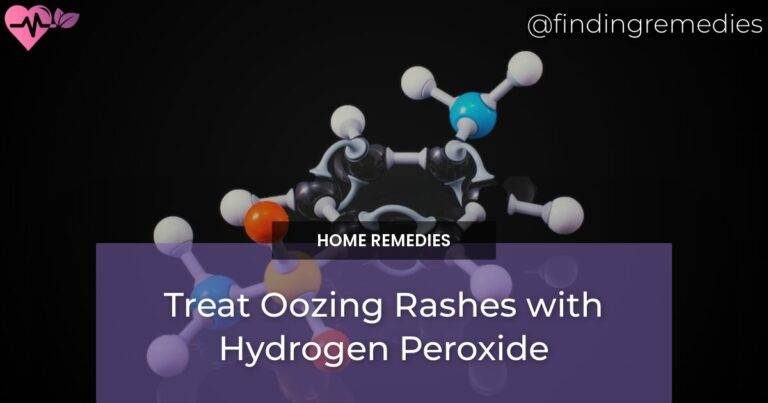Oozing rashes can be a bothersome and uncomfortable condition to deal with. Whether caused by allergies, insect bites, or infections, these oozing rashes can be both painful and unsightly. Fortunately, there is a simple and effective solution that you may not have considered: hydrogen peroxide. Found in most households, hydrogen peroxide is widely known for its antiseptic properties and ability to clean wounds. However, it can also be used to treat oozing rashes and provide relief from itching and irritation.
In this comprehensive guide, we will explore how hydrogen peroxide can be used as a first aid treatment for oozing rashes. From understanding the benefits of hydrogen peroxide to learning proper application techniques, we’ll cover everything you need to know to effectively use this versatile solution. So, let’s dive in and discover how hydrogen peroxide can help you find relief from oozing rashes and promote faster healing.
Table of Contents
The Benefits of Hydrogen Peroxide for Oozing Rashes
Hydrogen peroxide is a powerful disinfectant that can effectively kill bacteria and prevent infections. When applied to oozing rashes, it helps cleanse the affected area and remove any debris or foreign substances that may be contributing to the rash. Additionally, hydrogen peroxide has mild antiseptic properties that can help reduce the risk of secondary infections caused by scratching or itching the rash. Its bubbling action helps to lift away dead skin cells and promote the growth of new, healthy tissue. This makes hydrogen peroxide an excellent choice for treating oozing rashes, as it not only cleanses the affected area but also aids in the healing process.
How to Use Hydrogen Peroxide for Oozing Rashes
Before applying hydrogen peroxide to an oozing rash, it is important to clean the affected area with mild soap and water. This helps remove any dirt or debris that may be present on the skin’s surface, allowing the hydrogen peroxide to work more effectively. Once the area is clean and dry, you can apply the hydrogen peroxide using a cotton ball or sterile gauze. Gently dab the affected area, ensuring that the hydrogen peroxide comes into contact with the oozing rash. Avoid rubbing or scrubbing the rash, as this can further irritate the skin and potentially worsen the condition.
It is important to note that hydrogen peroxide may cause a mild stinging or burning sensation when applied to oozing rashes. This is normal and should subside after a few minutes. If the discomfort persists or worsens, discontinue use and consult a healthcare professional.
Precautions and Safety Guidelines
While hydrogen peroxide can be an effective treatment for oozing rashes, it is essential to use it safely and with caution. Here are some important precautions to keep in mind:
- Always dilute hydrogen peroxide: It is crucial to dilute hydrogen peroxide with equal parts of water before applying it to the skin. Concentrated hydrogen peroxide can cause skin irritation and damage.
- Do not use on open wounds: Hydrogen peroxide is not suitable for use on open wounds or deep cuts. It is intended for superficial skin conditions like oozing rashes.
- Avoid contact with eyes and mucous membranes: Hydrogen peroxide should not come into contact with the eyes or mucous membranes, as it can cause irritation and damage.
- Consult a healthcare professional: If you have any concerns or questions about using hydrogen peroxide for oozing rashes, it is always best to consult a healthcare professional for personalized advice.
By following these precautions and safety guidelines, you can safely and effectively use hydrogen peroxide to treat oozing rashes. However, if the rash worsens or persists after several days of treatment, it is advisable to seek medical attention.
Alternative Treatment Options for Oozing Rashes
While hydrogen peroxide can be an effective treatment for oozing rashes, it may not be suitable for everyone or every situation. If you prefer to explore alternative treatment options or your oozing rash does not improve with hydrogen peroxide, consider the following alternatives:
- Antibiotic ointments: Topical antibiotic ointments can help prevent infections and promote healing in oozing rashes. However, it is important to use them as directed and consult a healthcare professional if the rash persists.
- Cool compresses: Applying cool compresses to the oozing rash can help reduce inflammation and provide temporary relief from itching and discomfort.
- Over-the-counter antihistamines: If your oozing rash is caused by an allergic reaction, over-the-counter antihistamines may help alleviate itching and inflammation.
Remember, it is essential to consult a healthcare professional or dermatologist to determine the best course of treatment for your specific condition.
Conclusion
Hydrogen peroxide can be a valuable addition to your first aid kit when it comes to treating oozing rashes. Its antiseptic properties and ability to cleanse and promote healing make it an effective solution for relieving itching, reducing inflammation, and preventing infections. However, it is crucial to use hydrogen peroxide safely and properly, following the recommended precautions and guidelines. If your oozing rash does not improve or worsens after using hydrogen peroxide, it is advisable to seek medical attention for a proper diagnosis and alternative treatment options. Remember, taking care of your skin is essential for overall health and well-being.

